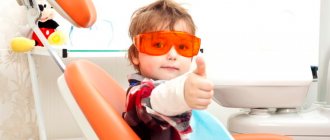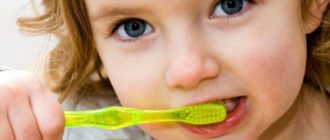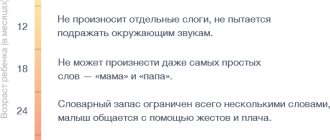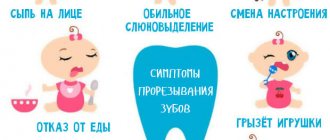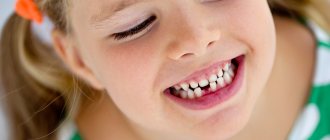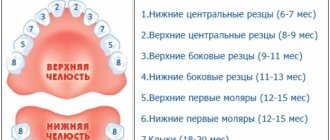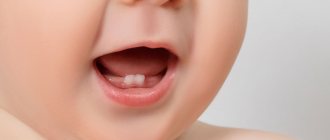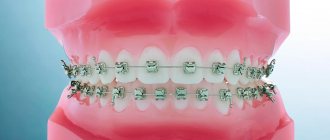Mom and dad can't wait for their child's baby teeth to begin to be replaced by molars. Such changes always raise a lot of questions. Usually molars grow without difficulty, but there is always a risk of complications. You can avoid possible unpleasant consequences if you regularly visit the pediatric dentist. The dental clinics of the Stomus network employ experienced and qualified specialists who can identify teething difficulties and help cope with them.
Anatomy of permanent teeth
Each molar consists of certain parts:
- crown. This is the part of the tooth that protrudes from the top;
- the root, it goes deep into the alveoli. At the same time, it is attached thanks to special connective tissue bundles. There can be different numbers of roots (1-5 pieces). This moment affects the number of nerves and channels;
- neck. This part is located between the root and the crown.
Tooth tissues are distinguished by their heterogeneity. The enamel is on top and is known for its durability. Once the tooth has erupted, it is covered with a transparent thin layer. This is the cuticle, which eventually changes to the pellicle. The latter is a film that is created from what saliva produces.
Beneath the enamel is dentin, the tissue of the tooth. Dentin is similar to bone when you study how it is built. However, it is more durable because there is a high level of mineralization. In the area where the root is located, the dental tissue is covered with cement. The latter is rich in mineral compounds and is also associated with periodontium. Collagen fibers are used for this.
As for the part of the tooth that is inside, this is the crown and root canal. They are filled with pulp. This is loose connective tissue; it contains nerve endings and blood vessels.
Intramaxillary development
The permanent bite is formed on the basis of dental plates, which are formed inside the pits of stratified squamous epithelium. At approximately the 5th month of the child’s embryonic development, an enamel organ appears along the lower edge of the primordial teeth. As mesenchyme grows into it, dental papillae and sacs are formed.
In total, each child has 20 rudiments in two jaws for the development of replacement permanent teeth, 16 of which are present at the time of birth, and the remaining 4 appear at 1-5 years of life. Being in the same alveolus with the milk sacs, after a while they are separated from them by a bone septum and are placed in separate sockets. The dental plates grow in a posterior direction. The main dental tissues are actively developing - dentin, pulp, enamel, as well as blood vessels and nerve fibers.
Differences between baby teeth and permanent teeth
Permanent and temporary teeth are built in the same way, but still have certain differences between themselves:
- The enamel on baby teeth is whiter. And the enamel on permanent teeth has a yellowish tint;
- the best indicators of density and mineralization are noted behind the molars;
- the pulp of a baby tooth is large in size, and the dense tissues and their walls are thinner;
- permanent teeth are larger in size, here the length is greater than the width;
- The root of baby teeth is short and thin compared to permanent teeth. When the root of temporary teeth is formed, they expand in width. Therefore, the permanent bud has free space to grow.
Formation of periodontium and roots
This stage of development begins after the eruption of permanent teeth and usually lasts for 3.5-5 years. It includes the development processes of surrounding tissues, as well as the root system. At the same time, the crown of permanent teeth at this stage is almost completely formed and is ready for active mineralization after eruption.
The period of development of the root part and periodontal tissues is divided into the following stages:
- active growth of the tooth root in length;
- development and strengthening of the root apex;
- uncovered root tip;
- formation and strengthening of periodontium;
- completion of periodontal and root development.
Where do teeth come from?
Teeth begin to form and develop when the fetus is still inside the womb (at about 6 weeks). They have their source - the epithelial dental plate. Already by 14 weeks, active formation of dental tissues, which are hard, occurs. Initially, this occurs in the area where the crown will be, and later at the root.
Molars, namely their first rudiments, appear by the 5th month of the embryo. They are located higher than the child’s baby teeth or lower. By the time the child is born, the rudiments are already practically formed in the tissues of the jaw.
Teeth that belong to an additional group (have no predecessors) are formed later. This occurs after about 1 year of life. Why? Because the baby's jaw is still very small and there is not enough space for them.
The completion of tooth root formation occurs at approximately this age:
| Teeth | Upper jaw, age | Lower jaw, age |
| Central incisors | 9-13 | 7-11 |
| Lateral incisors | 9-12 | 8-11 |
| Fangs | 9-12 | 9-12 |
| First premolars | 11-13 | 11-13 |
| Second premolars | 11-13 | 11-13 |
| First molars | 9-12 | 9-12 |
| Second molars | 14-15 | 14-15 |
Since the eruption of third molars does not occur at a specific time, it is impossible to establish a clear age at which their roots are formed.
X-ray results confirm the completion of the process of tooth root formation. The key signs are the absence of an opening at the apex, as well as a pronounced periodontal contour.
Thus, completion of dental growth, including full maturation, usually occurs only between the ages of 15 and 18 years. It is at this time that the maxillofacial apparatus already has the same dimensions as in adults.
What does a dental formula look like?
To make it more convenient to describe teeth and their number, special formulas are usually used. Each tooth has its own number, which is used to decipher its location.
When describing a milk bite, Roman numerals are used:
- incisors – I, II;
- canine – III;
- molars – IV, V.
If we talk about the formula for adult teeth, here the teeth are counted starting from the center:
- incisors – 1.2;
- fang – 3;
- molars (small) – 4.5;
- molars (large) – 6,7,8.
8 is a wisdom tooth; not every person has it.
Should I brush my newly erupted teeth?
Dentists strongly recommend starting to take care of oral hygiene from infancy. For newly emerging teeth, they offer special silicone brushes or wipes. A simpler option is a finger wrapped in gauze. You can simply moisten it with water or use toothpastes for children under 3 years of age (they are marked 0+ and can always be swallowed). The main thing when brushing your teeth is no violence! A little more cleanliness isn't worth the stress.
| Author Fedor Katasonov | Scientific editor Maria Gantman |
Teething order
Typically, all children start teething at about the same time. Teeth emerge from the molar set at the age of 5, and it is the molars (large ones) that emerge. Then the diagram is as follows:
- Initially, the incisors on the lower jaw change, which are located in the center;
- then the central incisors appear on the upper jaw and the incisors on the sides on the lower jaw;
- at about 8-9 years old, the incisors on the top and sides change;
- up to 12 years of age, molars (small) grow;
- at the age of 13, the fangs change;
- after the child turns 14 years old, the second molars (large ones) come in. They were not included in the milk kit;
- and after another 1 year the third molars (large) appear. This is a wisdom tooth. But he may not appear at all.
Timing and order of teething
No specialist can say with accuracy what time babies start teething. However, it is generally accepted that the first lower central incisors should appear when the baby is 6 months old. All 20 baby teeth should be in the mouth by the age of 3 years.
It also happens that children’s upper teeth come in first and they appear much later than 6 months. This process is not considered by experts as a deviation from the norm, because teeth begin to erupt from the gums in the sequence in which they were laid during the prenatal period.
Thus, dentists do not recommend focusing attention on which teeth come out first in a child. Despite this, the following scheme for the appearance of incisors in children is generally accepted; parents can partially rely on it if they wish:
- The central ones erupt first, and only then the lateral lower and upper incisors;
- molars, canines and second molars erupt next;
- predominantly the lower teeth appear first, and then the upper ones;
- The appearance of incisors in pairs is often observed; two pairs may even erupt at once.
A common phenomenon is when teeth come out in the wrong order. What to do in such a situation? It is advisable to contact a pediatric dentist to rule out abnormalities. The fact is that deviations in the timing and sequence of teething in children can be caused by the following reasons:
- calcium deficiency and the development of rickets;
- thyroid diseases;
- dysfunction of the digestive system;
- absence of incisors in the gums.
As a rule, there is no cause for concern if the child is under one year old and has no teeth.
How to determine that a child will soon have molars?
There are certain signs that indicate that permanent teeth will soon begin to erupt:
- The spaces between the teeth increase. The jaw grows and the free space increases;
- baby teeth become loose as the root gradually dissolves. It cannot be firmly fixed in the jaw tissues;
- in case of loss of a temporary tooth. This confirms that the molar will soon come out as it has pushed out the previous one;
- The gums are slightly swollen and red.
When permanent teeth erupt, the child’s general well-being usually remains the same, the temperature does not rise, and there is no pain.
What complications may arise?
Baby teeth did not fall out on time. The cause of the problem must be determined by the dentist. This usually requires an x-ray. In the image, the specialist can see the degree of development of the molars.
The appearance of caries and the occurrence of pulpitis. In this case, there is a change in body temperature, the appearance of severe pain and a general deterioration in the child’s well-being.
A very common situation occurs when a molar tooth (one or more) has already begun to appear, but the milk tooth does not fall out. As a result, the new tooth will look for other ways to grow, which will lead to a change in its direction and displacement. The result is a violation of the bite and the even position of the dentition. To eliminate the problem, you will need to consult an orthodontist.
Possible problems
Permanent teeth have just appeared, but this does not mean that there will not immediately be any problems associated with them. Parents should be aware of possible dental problems:
- lack of molars;
- pain in the molar area;
- crooked position of molars;
- molars fall out;
- injuries.
For any of these problems, it is important to contact a specialist in time to receive qualified help.
Symptoms
Usually, no serious problems arise during teething, but local (in rare cases systemic) disturbances are present. These include:
- swelling and soreness of the gums;
- profuse drooling;
- irritability;
- restless sleep;
- lethargy;
- the baby's need for biting and chewing;
- poor appetite.
Loose stools, low-grade fever and runny nose are less common than the above symptoms.
Important! If the body temperature rises above 38 degrees, convulsions, difficulty breathing, you need to show the baby to a doctor and call an ambulance. This may indicate a viral infectious disease and is not a sign of teething.
Some parents wonder why this process occurs differently in babies. For example, in some teething occurs with fever, in others it does not. It is noted that, among other factors, this is also influenced by the child’s constitutional type. In children of the allergic type, this period may be accompanied by increased moodiness, atopic dermatitis, and ARVI is often associated. Infants with asthenic syndrome sleep poorly, refuse to eat, and cry for a long time due to severe pain.
First teeth
When to expect
The baby's milk teeth are formed at the 7th–8th week of intrauterine development, and the permanent ones at the end of the 4th month of pregnancy. In total, a child develops 20 baby teeth, while 32 permanent teeth. To provide the baby with a Hollywood smile, the expectant mother needs to eat properly throughout the nine months of pregnancy. There are no calcium preparations that are 100% absorbable, so it is very important to get “natural” calcium from food, especially cottage cheese. And, of course, the pregnant woman herself needs to have all her teeth treated - now there are very gentle technologies for this.
The eruption of the first milk teeth in most cases begins at 3–8 months of the baby’s life and ends closer to three years. But it also happens that children are born with one or two teeth, or teeth may erupt in the first weeks of life. Often the timing of teething depends on genetic characteristics, but much more strongly on other factors. Diseases of the baby also affect the teeth (for example, with rickets, frequent ARVI and dyspepsia, teeth erupt later). It’s worth paying attention to the nature of your diet, the quality of drinking water, even the climate! On average, northern residents start teething a little later than southerners. Sometimes teething is delayed, and the first tooth appears closer to a year. Usually there is nothing wrong with this. It is believed that it is not so much the timing that speaks about a child’s health, but rather the order in which teeth erupt. If it is broken, pay attention to this fact and show the baby to the pediatric dentist.
The process has started
The fact that the teething process has begun is indicated by profuse salivation. In addition, the baby begins to put into his mouth everything that comes to hand. This means that the gums are itchy, causing him discomfort. Trying to relieve the itching, the baby instinctively acts correctly - micromassage of the gums improves microcirculation in them, teeth erupt easier and faster. During this period, provide your child with teethers: hypoallergenic silicone toys filled with water. The teether should not be cooled in the freezer - only in the refrigerator: otherwise the baby will get hurt on a hard surface. If the gums are very swollen and the baby is crying in pain, use special dental gels that have a mild local anesthetic effect.
For most children, the teething process goes quite smoothly. There may be short periods of anxiety, disturbances in daily routine and nutrition. Sometimes even teething is accompanied by diarrhea, runny nose, cough and fever. And during the period when teeth appear, the baby is vulnerable to all kinds of infections. The baby’s immunity is weakening these days, and it is easier for him to “catch” the virus, so you should not attribute the deterioration of the condition only to the teeth. If a child has a fever when a tooth is being cut, you need to look for another inflammatory source in the body.
At 6 months
The baby usually boasts central lower incisors. This is a reason to start brushing your teeth. Why so early? Baby teeth are small and sharp, have an uneven wavy edge, stand close to each other and, as a rule, have a yellowish tint. These teeth have a low degree of mineralization. Their enamel and dentin are very thin. All this contributes to the rapid occurrence and spread of caries. In order to prevent it, you need to regularly brush your teeth: for this you can use various massage brushes, which not only accustom the child to hygiene, but also facilitate the teething process itself. We immediately teach you how to brush your teeth correctly - from the gums to the edges, with slightly “sweeping”, semicircular movements, and in no case horizontally. If possible, brush your teeth after every meal (and at least twice a day). Isn't there such a possibility? Give the baby something to drink - the water will wash away any remaining food.
At 8 months
The upper central incisors usually erupt.
At 9 months,
the upper lateral incisors appear.
At 11 months,
many children's lower lateral incisors are already in place!
By the age of one year, a baby normally already has eight teeth
.
But there may not be any - delayed teething occurs in 25% of cases with normal psychomotor development of the child. In extremely rare cases, the absence of teeth is associated with adentia - the absence of their rudiments. This can be checked by a pediatric dentist using radiovisiography. By 13–15 months,
the upper first molars appear first, followed by the lower ones.
From the age of one year, your baby can brush his teeth with children's toothpaste and a special children's brush. The service life of the brush is no more than 2 months, even if it looks like new. Many kids swallow the tasty pasta. There is no need to be afraid of this if it is for children and its quantity is no more than a pea. Of course, until 2–2.5 years of age, teeth brushing should be done with the help and then under the watchful supervision of the mother.
At 18 months
fangs erupt.
Typically, these teeth cause more problems than others; their eruption is more painful, and this process is often accompanied by discomfort. At 20 months,
the second molars erupt.
And sometimes already at this age the mother can notice the first problems. Doctors reassure: carious baby teeth are not a reason to worry that permanent teeth will also be bad. As practice shows, there is no pattern here. Of course, if parents do not neglect disease prevention and dental hygiene. At 2.5 years old, a child normally has a full set of baby teeth.
There are 20 of them - 10 on each jaw .
Baby teeth don’t last very long – soon they will begin to fall out and permanent ones will appear in their place. Usually the change of teeth begins at about 5–6 years and lasts until the age of 20, when wisdom teeth erupt.
Starting from 6 months, you must come for a preventive examination twice a year. When this becomes a habit, the baby will not be afraid of doctors, and by the age of 7–8 years (when a visit to the clinic can no longer be avoided) he will sit completely calmly in the dental chair
In order for your baby’s teeth to grow strong and healthy, you need to start taking care of them almost before conception. It’s also better to meet the dentist early
Timing of eruption and loss of baby teeth
| Upper teeth | |||
| Tooth name | Period of eruption | Teething order | Drop date |
| Central incisor | 8 months – 1 year | 2 | 6–7 years |
| Lateral incisor | 9 months – 1 year 2 months | 3 | 7–8 years |
| Fang | 1 year 3 months – 1 year 10 months | 7 | 10–12 years |
| First molar | 1 year – 1 year 6 months | 5 | 9–11 years |
| Second molar | 2 years – 2 years 8 months | 10 | 10–12 years |
| Lower teeth | |||
| Central incisor | 6 months –10 months | 1 | 6–7 years |
| Lateral incisor | 10 months –1 year 4 months | 4 | 7–8 years |
| Fang | 1 year 4 months – 2 years | 8 | 9–12 years |
| First molar | 1 year 2 months – 1 year 7 months | 6 | 9–11 years |
| Second molar | 1 year 10 months – 2 years 8 months | 9 | 10–12 years |

